| This page is an incomplete draft and is in progress. Please contact Vectorspace if you have any questions during the construction. |
Background
Among many of the functions of the United States Forest Service (USFS) is the development and maintenance of Forest System roads that are relied upon by USFS and the public. The USFS uses these to maintain its forests, aid in fighting forest fires, allow public use, and other functions. General information for Waze editors begins at USFS is their Travel Management section. See the Editing Resources section below for more specific map resources.
Some of these roads can be critical to local populations not just for recreation, but for regular travel. Such use is likely more common in rural and western states than it is for urban or eastern states. At times, some well-maintained dirt roads may even be considered to the local population as equivalent to streets or primary streets.
The USFS specifically issues Motor Vehicle Use Maps (MVUM) that identify specifically where USFS allows use of their roads by public motor vehicles. Some of these roads are paved and well maintained, others are dirt but used like streets, while others are dirt roads that are not well maintained and will only accommodate 4x4 wheel vehicles. Some roads are only listed for motorcycle use. Note that these maps show only show roads that the USFS wants used by the public. There are other USFS roads that are closed or otherwise not authorized for public use.
Waze and Forest Service Roads
Creating accurate and properly represented USFS roads in Waze will:
- benefit large numbers of tourists and recreational users of USFS roads,
- allow those lost in some areas to navigate to regular roadways,
- allow local populations appropriate use of USFS roads,
- allow Waze editors to functionally classify roads by marking them with the appropriate Waze road type (street, 4x4, etc.),
- allow some roads to be marked as private to the USFS,
- allow identification of useful Waze Landmarks on USFS land,
- allow time-based restrictions on some roads that are closed in winter.
Functional Classification
There are two primary sources of information that Waze editors may obtain from the USFS:
- Motor Vehicle Use Maps (MVUMs), and
- Raw GIS data.
This section suggests a mapping of USFS roads to Waze roads depending on which source you use.
Motor Vehicle Use Maps (MVUMs)
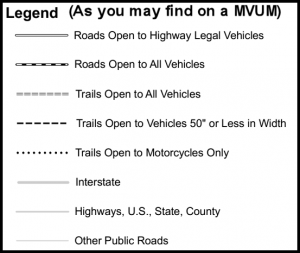
The key point of the USFS's Travel Management Rule is that motor vehicle use on National Forest System Lands is restricted to designated routes which are shown on the Motor Vehicle Use Maps (MVUMs). Only routes on the MVUMs should be entered into Waze. Of those roads and trails, only those accessible by passengers or 4x4 vehicles should be mapped. USFS shows trails specifically for motorcycle use only. These should not be added to the Waze map.
MVUMs can be found at the links at the end of this page via PDF maps and also an online GIS system that does not list maintenance level.
Only the first three and last three types should be mapped. Do not map trails restricted to vehicles 50" or less width or that are for motorcycles only.
Maintenance Levels & GIS Data

The US Forest Service classifies maintenance of National Forest System roads by five levels: 1, 2, 3, 4, and 5. Maintenance level 1 roads are closed to motor vehicle use. Maintenance level 2 roads are maintained for high-clearance (4x4, off-road) vehicles. Maintenance level 3, 4, and 5 roads are maintained for passage by standard passenger cars during the normal season of use.
Picking the best road types in Waze for the Forest Service roads is suggested in the following table. Levels 5, 4, and 3 are navigable by regular automobiles, but may not always be appropriate to be streets within the Waze map.
You will only find these Maintenance Levels in source GIS data from the USFS. This information is utilized by USFS to help create the MVUMs.
Maintenance Level Road Images
The following images, extracted from the USFS maintenance document above, provide examples from USFS for these road types. They may help illustrate differences between levels that will help you while editing. If you observe a USFS road in person, these images may help you determine the maintenance level.
| Maintenance Level |
Example A | Example B |
| Level 5 = Minor Highway Primary Street Street |

|
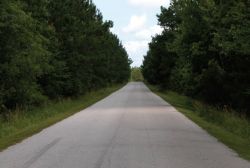
|
| Level 4 = Street |
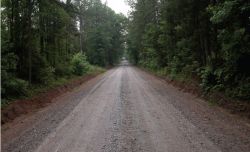
|
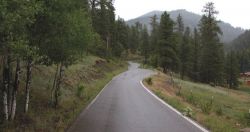
|
| Level 3 = Street |
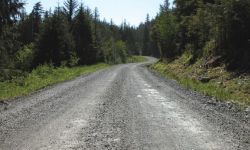
|
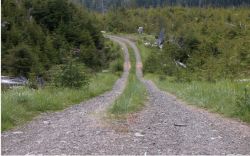
|
| Level 2 = Dirt Road / 4x4 Trail |
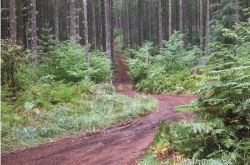
|
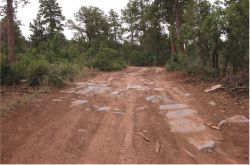
|
| Level 1 = Do Not Map |
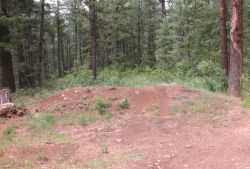
|
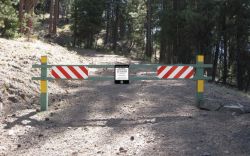
|
USFS to Waze Classification Mapping
<REWORKING THIS SECTION>
The key point of the USFS's Travel Management Rule is that motor vehicle use on National Forest System Lands is restricted to designated routes which are shown on the Motor Vehicle Use Maps (MVUMs). All routes not on the MVUMs should be marked as private. Note that we map most other roads not on the MVUMs because this may help those lost on USFS roads to navigate out of the area.
| USFS Maintenance Level |
Short Name |
Description | Suggested Waze Road Type |
| 5 | Highway | High traffic and speeds, usually paved, double lane, arterial or collector, typically connected to state and county roads. There are few of these roads in the inventory. | If shown on MVUM, select Minor Highway, Primary Street,or Street, otherwise Private |
| 4 | Paved | Moderate speeds, often dual lane, may be paved but usually aggregate surface, usually collectors, may connect to state and county roads | Street if shown on MVUM, otherwise Private |
| 3 | Passenger Vehicle |
Low speeds, single lane, local or collectors, may have potholes or washboarding | Street if shown on MVUM, otherwise Private |
| 2 | Unpaved 4x4 |
Unpaved local roads, may not be passable in inclement weather, high-clearance vehicles needed, not suitable for passenger cars. | Dirt Road/4x4 Trail if shown on MVUM, otherwise Private |
| 1 | Closed | Vehicular traffic is prohibited, might be used as a motorized trail for use by motorcycles, etc. | Private for existing roads. Do not map new roads. |
Level 5 & Level 3
Note that Levels 5 and 3 may have ambiguity for Waze Editors. This is because there may be large variability in local interpretation of the road type that is important to Wazers. In rural or some western states, some the very same type of USFS road may be best marked as a Minor Highway or Primary Street whereas in urban areas, they may be interpreted best as streets. Here are some suggestions.
USFS Level 5
- Pick the lowest level of road type that is reasonable for the surrounding area.
- Pick "Primary Street" or "Minor Highway" when the local function of this road is equivalent to those Waze road types.
USFS Level 3
- Preference is to always mark these roads as Waze type "Street."
- In rare cases pick "Dirt Road / 4x4 Trail" if you verify the road is in poor condition.
Mixed Type on Roads
Note that a a particular Forest Service Road may be only shown on the MVUM for a part of its distance. In such cases mark part of the road per the above table and the portion not on the MVUM as type Private.
Road Naming Conventions
There is wide variability in existing road names for roads on USFS land. Formal USFS road names you might see include "Forest Rd XXX," "F S XXX," and "Forest Svc Rd." Those that have significant public or popular use may have local road names with road signs. State highways and county roads may traverse USFS land, and will be named under conventions for those types of roads.
USFS Naming Conventions
These naming conventions may help you understand the online GIS maps and PDF maps available from USFS.
Naming is typically recursive based upon road stubs. For instance, if a main road has name "23" then stubs from that road may be, 23A, 23A1, 23A2, 23B, 23C, using alternating designators (letters, numbers). The third level of “23A1” is road 23, stub A, secondary stub 1. The exact choice is of this format is picked by different road engineers, so we cannot accurately predict something standard.
TBD
Waze Naming Conventions
The following convention is suggested for naming roads on USFS land:
- Public highways and county roads should be named under conventions for the state or region. Do not use a USFS road number/name for these roads.
- USFS roads on the MVUMs with popular names as shown on posted road signs should be named per the road signage. Note that the MVUMs do not usually show these popular names. Use street-view or drive by the location to verify before changing names from a popular name to a USFS road number/name.
- USFS roads on the MVUMs that are not named or with an alternative naming convention should be named "FS-XXXX" where XXXX is the USFS road name on the MVUM.
USFS Landmarks for Waze
Resources at USFS websites or USFS maps may be useful at correctly naming and adding USFS landmarks to the Waze Map. The following convention is suggested for some landmark types. Please refer to the other Waze landmark standards (link TBD) for additional guidance.
| USFS Item | Waze Landmark Type | How to place Waze Landmark |
| Campground | Park | Map campground to boarder of camping area including all roads and campsites. |
| Ranger Station | Government / Municipal Building | Map boarder of ranger station building and associated parking lot. |
| Visitor Center | Government / Municipal Building | Map boarder of visitor center building and associated parking lot. |
Editing Resources
The USFS Travel Management & Off-Highway Vehicle (OHV) Program website contains a number of resources that will be useful for Waze editors. Specific links follow.
Interactive Travel Map
The Interactive Travel Map is a GIS system for USFS land and roads. It shows the National Forest System roads, National Forest System trails, and areas on National Forest System lands that are designated for motor vehicle use. The map is searchable by vehicle class, time of year, route number, and travel mode. You can zoom into an area on a national forest or grassland, see the roads and trails in that area, and find out which ones are open to motor vehicles, and when. You can see rivers, lakes, mountain peaks, campgrounds, and topographic lines. Land ownership is shown by color. You can also print a map of the area you wish to visit.
This site may not have the most current data from every part of the United States, so make sure to check other resources. Data may not be available for all forests.
USFS Motor Vehicle Use Maps (MVUM)
Motor Vehicle Use Maps (MVUM) identify specifically where USFS allows use of their roads by public motor vehicles. They are available for a small fee in hard copy online, are free at USFS offices, or can be found online in PDF format.
A listing of forests that maintain MVUM is available as a great resource for Waze editors. From this link you must select the appropriate forest listed by state. On those pages will be listed the MVUMs that are available.
USFS GIS Data
We have arranged to get access to current GIS data sets from the various forests. Details on this data are being worked to provide easier access. Until we have details worked out, PM user vectorspace to obtain more information.